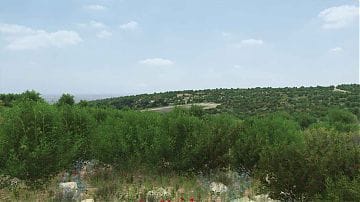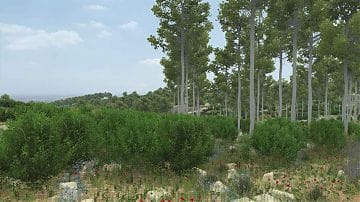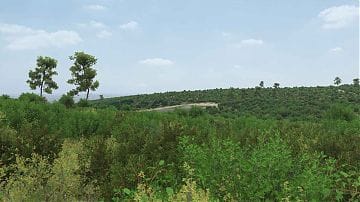
Simulation of management scenarios of the Ramat Hanadiv Nature Park
- Mission: 3D visualisation, 3D modelling
- Client: Ramat Hanadiv Naturpark, Israel
- Duration: 2011/05/01 - 2015/12/01
The Ramat Hanadiv Nature Park is located in the north of Israel between Zikhron Ya’akov and Binyamina and is very species-rich with its 617 plant species. Characteristic Mediterranean vegetation forms the landscape of the nature park. The diversity of species and vegetation structures is threatened by the fact that woody plants tend to spread further and displace especially herbaceous species. In the 1970s, Aleppo pines were planted, which change the vegetation through seed dispersal. A larger proportion of woody plants also increases the risk of forest fires. This development is counteracted with targeted landscape management measures. Certain areas are grazed by goats, others by sheep. In addition, woody plants are actively removed from the landscape.
The foundation that manages the park conducts extensive research to ensure the sustainable development of the park landscape. To this end, various scenarios are being developed in order to meet the needs of people, animals and plants alike within the framework conditions described.
In order to make these scenarios and the respective visual changes in the landscape tangible, Lenné3D was commissioned to create a comprehensive 3D landscape model of the nature park. The most important part of the assignment was first of all the accurate 3D modelling of the present situation in terms of vegetation. Based on the existing situation, a total of seven management scenarios of the nature park could then be modelled and visualised. The work was carried out in close coordination and cooperation with scientists and nature park staff on site.
The following work steps were implemented by Lenné3D during the project work for the simulation of the management scenarios:
- Analysis and evaluation of LIDAR data and LTER transects to generate vegetation distributions (relevant parameters: Cover rates, heights and sociabilities of plant species),
- Determination of key plant species and modelling of realistic 3D plant models,
- Concretisation, coordination and control of the eight vegetation types in three layers each (tree, shrub, herb layer) as well as the 3D plant models,
- 3D modelling of the terrain surface with rocks and surface texturing,
- Representation of the current state of vegetation distribution based on eight vegetation types,
- Representation of future scenarios depending on landscape management and based on the inventory,
- Adjustment of vegetation patterns (cover, height, sociability) based on scientific studies and definitions for all scenarios.
The 3D landscape model visualises the extent of vegetation on a horizontal and vertical level. Variations of the visualisations make it possible to directly compare the different vegetation developments depending on the landscape management in before and after representations.
The simulation of the different management scenarios supports future decisions on sustainable intervention in the nature park landscape. They also serve as communication tools in an exhibition of the affiliated visitor centre and are used on the nature park’s website.






